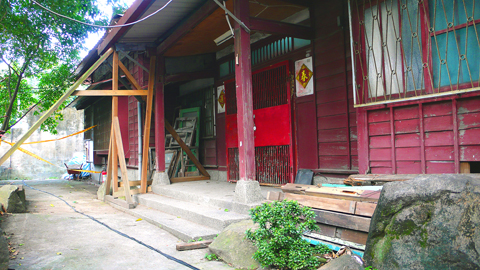The Taipei City Government yesterday started a restoration project on a group of Japanese-style houses built on Qidong Street in the 1920s in an effort to preserve the city’s largest group of such buildings.
The narrow street, located at the intersection of Zhongxiao E Road and Jinshan S Road, has a total of 10 houses built for civil servants during the Japanese colonial era. Occupying more than 6,800m², this kind of architecture has become rare even in Japan, Taipei City’s Department of Cultural Affairs said.
“The wooden structures make the preservation of historical Japanese buildings a challenge, and even in Japan, most old buildings were destroyed or dismantled to make way for urban renewal projects,” Teng Wen-tsung (鄧文宗), a division chief in the department, said during a press conference in front of the houses yesterday.

PHOTO: LIN HSIANG-MEI, TAIPEI TIMES
The area originally comprised 17 houses, but seven were torn down by Bank of Taiwan, which owned the land, in 2002.
To preserve the remaining houses, the government revised regulations in the Cultural Assets Preservation Act (文化資產保存法) and protected the houses as “temporary historical sites” before formally listing them as municipal historical sites in 2004.
Although the 10 remaining houses have been abandoned for years, the interior decorations and a total of 12 old trees are well preserved, Teng said.
The buildings show how people lived during the Japanese colonial era, Teng said.
The restoration project will cost NT$22 million (US$650,000) and will be completed next year.
Chu Chen Pao-kuei (褚陳寶貴), a local resident, said the efforts to preserve the houses were initiated by the local community. The community will cooperate with the department and the Council of Cultural Affairs to preserve the buildings, Chu said.
Lee Yong-ping (李永萍), commissioner of the department, said the restored houses would be open to the public.

LOW RISK: Most nations do not extradite people accused of political crimes, and the UN says extradition can only happen if the act is a crime in both countries, an official said China yesterday issued wanted notices for two Taiwanese influencers, accusing them of committing “separatist acts” by criticizing Beijing, amid broadening concerns over China’s state-directed transnational repression. The Quanzhou Public Security Bureau in a notice posted online said police are offering a reward of up to 25,000 yuan (US$3,523) for information that could contribute to the investigation or apprehension of pro-Taiwanese independence YouTuber Wen Tzu-yu (溫子渝),who is known as Pa Chiung (八炯) online, and rapper Chen Po-yuan (陳柏源). Wen and Chen are suspected of spreading content that supported secession from China, slandered Chinese policies that benefit Taiwanese and discrimination against Chinese spouses of

ALIGNED THINKING: Taiwan and Japan have a mutual interest in trade, culture and engineering, and can work together for stability, Cho Jung-tai said Taiwan and Japan are two like-minded countries willing to work together to form a “safety barrier” in the Indo-Pacific region, Premier Cho Jung-tai (卓榮泰) yesterday said at the opening ceremony of the 35th Taiwan-Japan Modern Engineering and Technology Symposium in Taipei. Taiwan and Japan are close geographically and closer emotionally, he added. Citing the overflowing of a barrier lake in the Mataian River (馬太鞍溪) in September, Cho said the submersible water level sensors given by Japan during the disaster helped Taiwan monitor the lake’s water levels more accurately. Japan also provided a lot of vaccines early in the outbreak of the COVID-19 pandemic,

PROMOTION: Travelers who want a free stopover must book their flights with designated travel agents, such as Lion Travel, Holiday Tours, Cola Tour and Life Tours Air Canada yesterday said it is offering Taiwanese travelers who are headed to North America free stopovers if they transit though airports in Japan and South Korea. The promotion was launched in response to a potential rise in demand for flights to North America in June and July next year, when the US, Canada and Mexico are scheduled to jointly host the FIFA World Cup, Air Canada said. Air Canada offers services to 13 of the 16 host cities of the tournament’s soccer games, including Toronto and Vancouver; Mexico City, Guadalajara and Monterrey in Mexico; Atlanta, Georgia; Boston; Dallas; Houston;

The US approved the possible sale to Taiwan of fighter jet spare and repair parts for US$330 million, the Pentagon said late yesterday, marking the first such potential transaction since US President Donald Trump took office in January. "The proposed sale will improve the recipient's capability to meet current and future threats by maintaining the operational readiness of the recipient's fleet of F-16, C-130," and other aircraft, the Pentagon said in a statement. Trump previously said that Chinese President Xi Jinping (習近平) has told him he would not invade Taiwan while the Republican leader is in office. The announcement of the possible arms